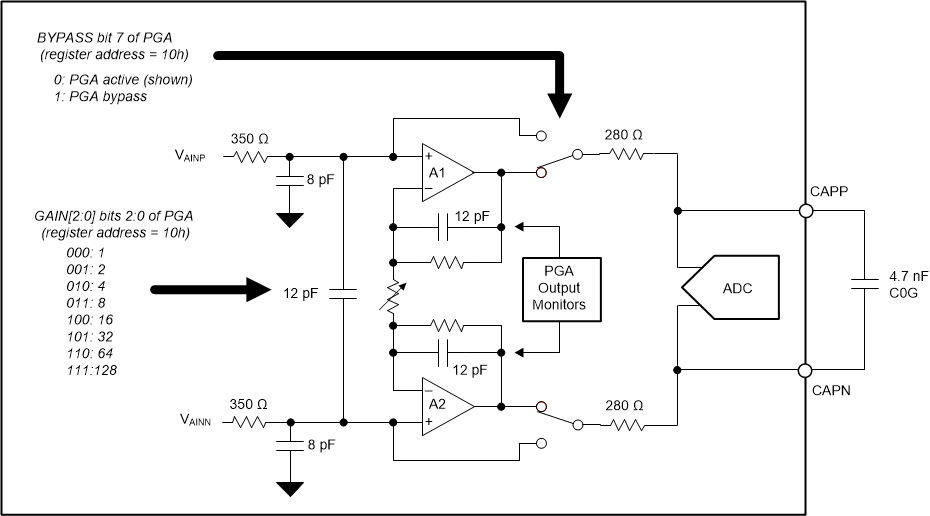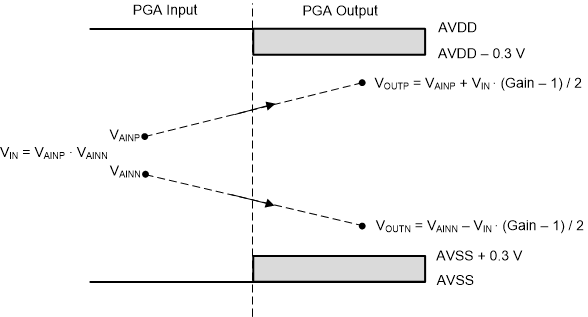JAJSF13C March 2018 – January 2019 ADS1260 , ADS1261
PRODUCTION DATA.
- 1 特長
- 2 アプリケーション
- 3 概要
- 4 改訂履歴
- 5 概要(続き)
- 6 Device Comparison Table
- 7 Pin Configuration and Functions
- 8 Specifications
- 9 Parameter Measurement Information
-
10Detailed Description
- 10.1 Overview
- 10.2 Functional Block Diagram
- 10.3 Feature Description
- 10.4
Device Functional Modes
- 10.4.1 Conversion Control
- 10.4.2 Chop Mode
- 10.4.3 AC-Excitation Mode
- 10.4.4 ADC Clock Mode
- 10.4.5 Power-Down Mode
- 10.4.6 Reset
- 10.4.7 Calibration
- 10.5 Programming
- 10.6
Register Map
- 10.6.1 Device Identification (ID) Register (address = 00h) [reset = xxh]
- 10.6.2 Device Status (STATUS) Register (address = 01h) [reset = 01h]
- 10.6.3 Mode 0 (MODE0) Register (address = 02h) [reset = 24h]
- 10.6.4 Mode 1 (MODE1) Register (address = 03h) [reset = 01h]
- 10.6.5 Mode 2 (MODE2) Register (address = 04h) [reset = 00h]
- 10.6.6 Mode 3 (MODE3) Register (address = 05h) [reset = 00h]
- 10.6.7 Reference Configuration (REF) Register (address = 06h) [reset = 05h]
- 10.6.8 Offset Calibration (OFCALx) Registers (address = 07h, 08h, 09h) [reset = 00h, 00h, 00h]
- 10.6.9 Full-Scale Calibration (FSCALx) Registers (address = 0Ah, 0Bh, 0Ch) [reset = 00h, 00h, 40h]
- 10.6.10 IDAC Multiplexer (IMUX) Register (address = 0Dh) [reset = FFh]
- 10.6.11 IDAC Magnitude (IMAG) Register (address = 0Eh) [reset = 00h]
- 10.6.12 Reserved (RESERVED) Register (address = 0Fh) [reset = 00h]
- 10.6.13 PGA Configuration (PGA) Register (address = 10h) [reset = 00h]
- 10.6.14 Input Multiplexer (INPMUX) Register (address = 11h) [reset = FFh]
- 10.6.15 Input Bias (INPBIAS) Register (address = 12h) [reset = 00h]
- 11Application and Implementation
- 12Power Supply Recommendations
- 13Layout
- 14デバイスおよびドキュメントのサポート
- 15メカニカル、パッケージ、および注文情報
10.3.2 PGA
The PGA is a low-noise, CMOS differential-input, differential-output amplifier. The PGA extends the dynamic range of the ADC, important when used with low level sensors. The PGA provides gains of 1 through 32 and the ADC provides additional gains of 2 and 4. The combined gains are 1 through 128. Gain is controlled by the GAIN[2:0] register bits as shown in Figure 49. In PGA bypass mode, the input voltage range extends to the analog supplies. The PGA is powered down in bypass mode.
 Figure 49. PGA Block Diagram
Figure 49. PGA Block Diagram The PGA consists of two chopper-stabilized amplifiers (A1 and A2), and a resistor network that determines the PGA gain. The resistor network is precision matched, providing low drift performance. The PGA integrates noise filters to reduce sensitivity to electromagnetic-interference (EMI). The PGA output is monitored to indicate when the operating headroom is exceeded.
Pins CAPP and CAPN are the PGA positive and negative outputs, respectively. Connect an external 4.7-nF capacitor (type C0G) as shown in Figure 49. The capacitor filters the modulator sample pulses and with the internal resistors, forms the antialias filter. Place the capacitor as close as possible to the pins using short traces. Avoid running clock traces or other digital traces close to these pins.
The full-scale differential input voltage range of the ADC is determined by the reference voltage and gain. Table 4 shows the differential input voltage range verses gain for VREF = 2.5 V.
Table 4. Full-Scale Voltage Range
| GAIN[2:0] BITS | GAIN | FULL-SCALE DIFFERENTIAL INPUT RANGE(1) |
|---|---|---|
| 000 | 1 | ±2.500 V |
| 001 | 2 | ±1.250 V |
| 010 | 4 | ±0.625 V |
| 011 | 8 | ±0.312 V |
| 100 | 16 | ±0.156 V |
| 101 | 32 | ±0.078 V |
| 110 | 64 | ±0.039 V |
| 111 | 128 | ±0.0195 V |
As with many amplifiers, the PGA has an input voltage range limitation that must not be exceeded in order to maintain linear operation. The specified input voltage range is expressed as the absolute voltage at the positive and negative inputs. As specified in Equation 5, the specified absolute input voltage depends on gain, the expected maximum differential voltage, and the minimum analog power-supply voltage.
where
- VAINP, VAINN = absolute input voltage
- VIN = maximum differential input voltage = VAINP - VAINN
- Gain (for gains = 64 and 128, use gain = 32 in the calculation)
- AVDD = minimum AVDD voltage
- AVSS = maximum AVSS voltage
The relationship of the PGA input to the PGA output is shown graphically in Figure 50. The PGA output voltages (VOUTP, VOUTN) depend on the respective absolute input voltage, the differential input voltage, and the PGA gain. To maintain the PGA within the linear operating range, the PGA output voltages must not exceed either AVDD – 0.3 V or AVSS + 0.3 V. The diagram depicts a positive differential input voltage that results in a positive differential output voltage.
 Figure 50. PGA Input/Output Range
Figure 50. PGA Input/Output Range